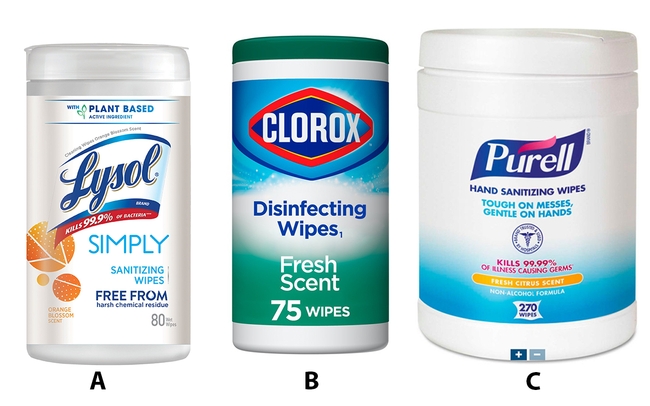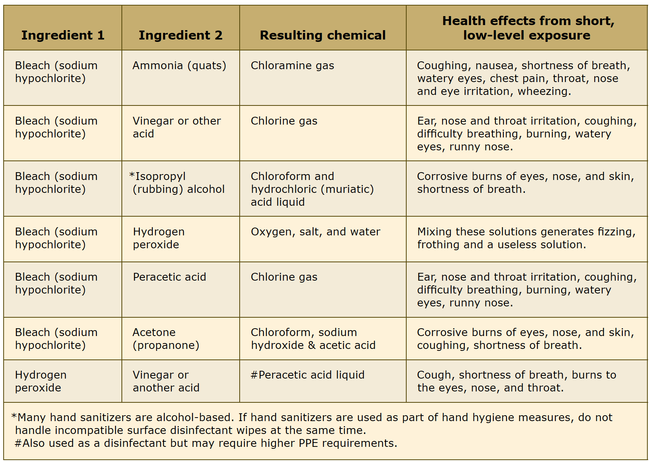As many school students resume in-person classes, some school districts are requesting students bring disinfectant wipes into school from home. Disposable, disinfectant wipes may seem a simple and convenient solution to in-class cleaning and disinfection needs, but there are several factors school communities must consider.
Disinfectant wipes are pesticides
Disinfectant wipes are registered by the U.S. Environmental Protection Agency (EPA) as antimicrobial pesticides designed to kill or inactivate microbes (germs). Many have “KEEP OUT OF REACH OF CHILDREN” clearly stated on containers. Disinfection products should not be used by children or near children.
Most K-12 students are legal minors under the age of 18 so may not use disinfectant wipes. Students, because of their developmental stage in life, have unique vulnerabilities leaving them prone to negative effects after chemical exposure. Younger students are also more likely to use wipes inappropriately, for example, using them to wipe their hands and faces.
Disposable wipes are not all the same
Disposable wipes may look similar, but they come in different forms designed for very different uses and cannot be used interchangeably. Accordingly, wipes come with differing directions for use. Figure 1 shows a few different types: (A) EPA registered surface sanitizing wipes that can be used on “food contact” surfaces. (B) EPA registered disinfectant wipes for non-food-contact surfaces. (C) FDA regulated hand sanitizing wipes. These are over-the-counter products for your hands and are not designed for cleaning surfaces.
Cleaning, sanitizing, and disinfecting
Pesticide label references to “cleaning”, “disinfecting” and “sanitizing” properties mean different things. Cleaning removes bacteria, virus, and other pathogens (germs), dirt, and impurities from surfaces or objects. Cleaning alone does not kill or deactivate all germs.
Disinfectants contain chemicals that kill or deactivate specific pathogens indicated on labels. They are used to disinfect surfaces or objects. Only wipes listed in the EPA's List N: Disinfectants for Use Against SARS-CoV-2 (COVID-19) are approved for use against SARS-CoV-2, and only if they are used according to label directions.
Sanitizing products use chemicals to lower the number of pathogens on surfaces or objects to a safe level, as judged by public health standards or requirements.
Some products are EPA approved as both a sanitizer and a disinfectant, however contact times differ and are pathogen specific. Currently, there are no sanitizer-only products with approved virus claims. For this reason, sanitizers do not qualify for inclusion on EPA's List N.
Products for “surface” sanitizing (EPA antimicrobial pesticide) and “hand” sanitizing (FDA over-the-counter drug) may look very similar. Some have different ingredients, while some have similar ingredients. However, these products are regulated by two different agencies, and are NOT interchangeable.
New CDC guidance
New cleaning and disinfection guidance was released April 5, 2021 by the Centers for Disease Control and Prevention. While the SARS-CoV-2 virus is primarily airborne, it is possible for people to be infected by contacting contaminated surfaces.
Cleaning with products containing soap or detergent reduces germs on surfaces by removing contaminants and may also weaken or damage some of the virus particles, decreasing infection risk from surfaces.
When no people with confirmed or suspected COVID-19 infections are known to have been in a space, cleaning once a day is usually enough to sufficiently remove virus particles that may be on surfaces and help maintain a healthy facility. Disinfecting using List N productsdestroys any remaining germs on surfaces, which further reduces any risk of spreading infection.
You may want to either clean more frequently or choose to disinfect (in addition to cleaning) in shared spaces if:
- There is a high transmission of COVID-19 in your community,
- Low number of people wearing masks who aren't vaccinated,
- Infrequent hand hygiene, or
- The space is occupied by certain populations, such as people at increased risk for severe illness from COVID-19
If there has been a sick person or someone who tested positive for COVID-19 in your facility within the last 24 hours, you should clean AND disinfect the space.
Label requirements
Use of disinfectant wipes may incur regulatory compliance challenges and lost time learning time in class. Some wipes may require the use of chemically resistant gloves and hands shouldalways be washed with soap and water after using disinfectant wipes, even if gloves are worn.
For teachers and students transitioning classrooms 6-8 times a day, 5 days a week, the use of disinfectants before each transition can incur unusual chemical exposure. Store-bought disinfectant products used in this way far exceeds the frequency and duration of normal consumer use. Therefore, the use of such products would necessitate inclusion in an employer's hazard communication program. This would involve training on hazards and precautions, and staff access to product labels in a familiar language and safety data sheets at each location.
Health and safety risks
Recent events have documented increases in negative health impacts caused by cleaning and disinfection in both homes and school settings. Many ingredients in wipes can pose health and safety risks. Wipes come with different active ingredients and additives. Commonly found active ingredients such as chlorine bleach (sodium hypochlorite), and quaternary ammonium compounds (benzalkonium chlorides can irritate eyes, skin and trigger asthma symptoms. Inert ingredients can also be problematic. Adequate ventilation while using products is vitally important.
To find options with lower risk look for the EPA Design for the Environment logo on products. Safer active ingredients for disinfectants currently available include hydrogen peroxide, citric acid, lactic acid, and ethanol.
Don't mix products
Mixing products can result in serious injury or death. NEVER mix a disinfectant with another disinfectant, home-made cleaning solutions, store-bought cleaning products or hand sanitizer. For example, mixing chlorine bleach and ammonia cleaners can lead to the production of potentially lethal chlorine gas (Table 1).
Storage requirements
Disinfectant wipes have specific storage requirements including temperature limits, ventilation requirements, shelf-life expiration dates, chemical separation requirements, and storage out of reach of children. Never store disinfectants under classroom sinks, on overhead shelving, or in student accessible areas.
For more information about cleaning and disinfecting, see these resources:
- CDC information on cleaning and disinfecting facilities
- CDC on surface cleaning and disinfection needs
- The National Pesticide Information Center (NPIC) information about antimicrobial pesticides
- US EPA factsheet on cleaning and disinfecting
- US EPA list N: Disinfectants for Use Against SARS-CoV-2 (COVID-19)
- US EPA directory of disinfectants that meet Design for the Environment standards
[Original article published in the Spring 2021 issue of the Retail Newsletter.]

